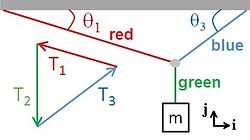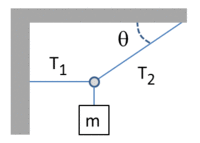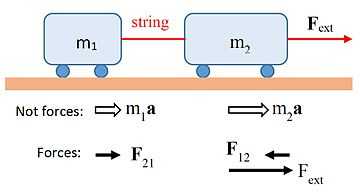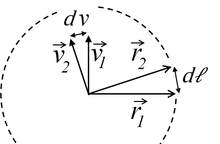Quizbank/Calculus Physics I/T2study
< Quizbank < Calculus Physics ICalcPhys1T2_Study
If you are reading this as a Wikiversity page, proper pagebreaks should result if printed using your browser's print option. On Chrome, Explorer, and Firefox, this option is available in the upper right hand corner of your screen. But, pagebreaks do not render properly if you use "Printable version" on Wikiversity's Print/export option on the left-hand sidebar.
- This document contains either a study guide OR pairs of exams taken from the same exam bank
- If two exams have the same s-number, then v1 and v2 have the same questions, presented in different (random) order.
- Exams with different s-numbers have different questions and may not have the same difficulty.
- Click items in the table of contents and appropriate page should be reached. This feature should allow you to print only those pages that you need.
- At the end of this document
- Attribution for the quizzes identifies where the questions were obtained
- Study guide links reading materials and/or relevant equations.
CalcPhys1T2_Study-v1s1
1. A sled of mass 5.5 kg is at rest on a rough surface. A string pulls with a tension of 46.8N at an angle of 40 degress above the horizontal. What is the magnitude of the friction?
- ___a) 27.11 N.
- ___b) 31.17 N.
- ___c) 35.85 N.
- ___d) 41.23 N.
- ___e) 47.41 N.
2. A sled of mass 5.2 kg is at rest on a rough surface. A string pulls with a tension of 45.3N at an angle of 59 degress above the horizontal. What is the normal force?
- ___a) 10.55 N.
- ___b) 12.13 N.
- ___c) 13.95 N.
- ___d) 16.04 N.
- ___e) 18.45 N.
3. A sled of mass 5.2 kg is at rest on a perfectly smooth surface. A string pulls with a tension of 41.3N at an angle of 55 degress above the horizontal. How long will it take to reach a speed of 9.8 m/s?
- ___a) 1.87 s
- ___b) 2.15 s
- ___c) 2.47 s
- ___d) 2.85 s
- ___e) 3.27 s
4. A sled of mass 2.5 kg is on perfectly smooth surface. A string pulls with a tension of 17.7N. At what angle above the horizontal must the string pull in order to achieve an accelerations of 3.1 m/s2?
- ___a) 48.4 degrees
- ___b) 55.7 degrees
- ___c) 64 degrees
- ___d) 73.6 degrees
- ___e) 84.7 degrees
5.

In the figure shown, θ1 is 18 degrees, and θ3 is 35 degrees. The tension T3 is 48 N. What is the tension, T1?
- ___a) 31.26 N.
- ___b) 35.95 N.
- ___c) 41.34 N.
- ___d) 47.54 N.
- ___e) 54.68 N.
6. In the figure "3 tensions" shown above θ1 is 18 degrees, and θ3 is 35 degrees. The tension T3 is 48 N. What is the weight?
- ___a) 40.3 N.
- ___b) 46.4 N.
- ___c) 53.3 N.
- ___d) 61.3 N.
- ___e) 70.5 N.
7.

In the figure shown, θ is 33 degrees, and the mass is 2.8 kg. What is T2?
- ___a) 50.38 N.
- ___b) 57.94 N.
- ___c) 66.63 N.
- ___d) 76.62 N.
- ___e) 88.12 N.
8.

In the figure shown, θ is 33 degrees, and the mass is 3.7 kg. What is T1?
- ___a) 46.5 N.
- ___b) 55.8 N.
- ___c) 67 N.
- ___d) 80.4 N.
- ___e) 96.5 N.
9.

In the figure shown, θ1 is 18 degrees , and θ3 is 29 degrees . The mass has a weight of 50 N. What is the tension, T1?
- ___a) 34.19 N.
- ___b) 39.32 N.
- ___c) 45.21 N.
- ___d) 52 N.
- ___e) 59.79 N.
10. A mass with weight (mg) of 49 newtons is suspended symmetrically from two strings. The angle between the two strings (i.e. where they are attached to the mass) is 54 degrees. What is the tension in the string?
- ___a) 27.5 N.
- ___b) 31.6 N.
- ___c) 36.4 N.
- ___d) 41.8 N.
- ___e) 48.1 N.
11. A mass with weight (mg) equal to 33 newtons is suspended symmetrically from two strings. Each string makes the (same) angle of 72 degrees with respect to the horizontal. What is the tension in each string?
- ___a) 9.9 N.
- ___b) 11.4 N.
- ___c) 13.1 N.
- ___d) 15.1 N.
- ___e) 17.3 N.
12. A 2.4 kg mass is sliding along a surface that has a kinetic coefficient of friction equal to 0.68 . In addition to the surface friction, there is also an air drag equal to 6 N. What is the magnitude (absolute value) of the acceleration?
- ___a) 9.2 m/s2.
- ___b) 10.5 m/s2.
- ___c) 12.1 m/s2.
- ___d) 13.9 m/s2.
- ___e) 16 m/s2.
13. A mass with weight (mg) 6.8 newtons is on a horzontal surface. It is being pulled on by a string at an angle of 30 degrees above the horizontal, with a force equal to 2.5 newtons. If this is the maximum force before the block starts to move, what is the static coefficient of friction?
- ___a) 0.19
- ___b) 0.23
- ___c) 0.27
- ___d) 0.33
- ___e) 0.39
14.

In the figure shown, the mass of m1 is 5.1 kg, and the mass of m2 is 2.8 kg. If the external force, Fext on m2 is 148 N, what is the tension in the connecting string? Assume no friction is present.
- ___a) 95.5 N
- ___b) 109.9 N
- ___c) 126.4 N
- ___d) 145.3 N
- ___e) 167.1 N
15.

In the figure shown (with m1 = 5.1 kg, m2 = 3.5 kg, and Fext = 135 N), what is the acceleration? Assume no friction is present.
- ___a) 13.7 m/s2
- ___b) 15.7 m/s2
- ___c) 18.1 m/s2
- ___d) 20.8 m/s2
- ___e) 23.9 m/s2
16. Nine barefoot baseball players, with a total mass of 692 kg plays tug of war against five basketball players wearing shoes that provide a static coefficient of friction of 0.61 . The net mass of the (shoed) basketball team is 406 kg. What is the maximum coefficient of the barefoot boys if they lose?
- ___a) 0.358
- ___b) 0.394
- ___c) 0.433
- ___d) 0.476
- ___e) 0.524
17. Without their shoes, members of a 9 person baseball team have a coefficient of static friction of only 0.23 . But the team wins a game of tug of war due to their superior mass of 607 kg. They are playing against a 5 person basketball team with a net mass of 429 kg. What is the maximum coefficient of static friction of the basketball team?
- ___a) 0.269
- ___b) 0.296
- ___c) 0.325
- ___d) 0.358
- ___e) 0.394
18.

In the figure shown, the mass of m1 is 5.7 kg, and the mass of m2 is 2.5 kg. If the external force, Fext on m2 is 159 N, what is the tension in the connecting string? Assume that m1 has a kinetic coefficient of friction equal to 0.34, and that for m2 the coefficient is 0.46 .
- ___a) 82 N
- ___b) 94.3 N
- ___c) 108.5 N
- ___d) 124.8 N
- ___e) 143.5 N
19. A merry-go-round has an angular frequency,  , equal to 0.188 rad/sec. How many minutes does it take to complete 6.5 revolutions?
, equal to 0.188 rad/sec. How many minutes does it take to complete 6.5 revolutions?
- ___a) 2.74 minutes.
- ___b) 3.15 minutes.
- ___c) 3.62 minutes.
- ___d) 4.16 minutes.
- ___e) 4.79 minutes.
20. A merry-go round has a period of 0.26 minutes. What is the centripetal force on a 53.3 kg person who is standing 1.35 meters from the center?
- ___a) 7.7 newtons.
- ___b) 8.8 newtons.
- ___c) 10.2 newtons.
- ___d) 11.7 newtons.
- ___e) 13.4 newtons.
21. A merry-go round has a period of 0.34 minutes. What is the minimum coefficient of static friction that would allow a 51.4 kg person to stand3.09 meters from the center, without grabbing something?
- ___a) 0.017
- ___b) 0.02
- ___c) 0.023
- ___d) 0.026
- ___e) 0.03
22. What is the gravitational acceleration on a plant that is 2.21 times more massive than Earth, and a radius that is 1.74 times greater than Earths?
- ___a) 4.1 m/s2
- ___b) 4.7 m/s2
- ___c) 5.4 m/s2
- ___d) 6.2 m/s2
- ___e) 7.2 m/s2
23. What is the gravitational acceleration on a plant that is 2.01 times more dense than Earth, and a radius that is 1.54 times greater than Earth's?
- ___a) 26.4 m/s2
- ___b) 30.3 m/s2
- ___c) 34.9 m/s2
- ___d) 40.1 m/s2
- ___e) 46.1 m/s2
24.

Is  valid for uniform circular motion?
valid for uniform circular motion?
- ___ a) Yes
- ___ b) No
25.

Is  valid for uniform circular motion?
valid for uniform circular motion?
- ___ a) Yes
- ___ b) No
26.

Is  valid for uniform circular motion?
valid for uniform circular motion?
- ___ a) Yes
- ___ b) No
27.

Is  valid for uniform circular motion?
valid for uniform circular motion?
- ___ a) Yes
- ___ b) No
28.

Is  valid for uniform circular motion?
valid for uniform circular motion?
- ___ a) Yes
- ___ b) No
29.

Is  valid for uniform circular motion?
valid for uniform circular motion?
- ___ a) Yes
- ___ b) No
30.

Is  valid for uniform circular motion?
valid for uniform circular motion?
- ___ a) Yes
- ___ b) No
31.

Is  valid for uniform circular motion?
valid for uniform circular motion?
- ___ a) Yes
- ___ b) No
32.

Is  valid for uniform circular motion?
valid for uniform circular motion?
- ___ a) Yes
- ___ b) No
33.

Is  valid for uniform circular motion?
valid for uniform circular motion?
- ___ a) Yes
- ___ b) No
34.

Is  valid for uniform circular motion?
valid for uniform circular motion?
- ___ a) Yes
- ___ b) No
35.

Is  valid for uniform circular motion?
valid for uniform circular motion?
- ___ a) Yes
- ___ b) No
36.

Is  valid for uniform circular motion?
valid for uniform circular motion?
- ___ a) Yes
- ___ b) No
37.

Is  valid for uniform circular motion?
valid for uniform circular motion?
- ___ a) Yes
- ___ b) No
Key to CalcPhys1T2_Study-v1s1
1. A sled of mass 5.5 kg is at rest on a rough surface. A string pulls with a tension of 46.8N at an angle of 40 degress above the horizontal. What is the magnitude of the friction?
- -a) 27.11 N.
- -b) 31.17 N.
- +c) 35.85 N.
- -d) 41.23 N.
- -e) 47.41 N.
2. A sled of mass 5.2 kg is at rest on a rough surface. A string pulls with a tension of 45.3N at an angle of 59 degress above the horizontal. What is the normal force?
- -a) 10.55 N.
- +b) 12.13 N.
- -c) 13.95 N.
- -d) 16.04 N.
- -e) 18.45 N.
3. A sled of mass 5.2 kg is at rest on a perfectly smooth surface. A string pulls with a tension of 41.3N at an angle of 55 degress above the horizontal. How long will it take to reach a speed of 9.8 m/s?
- -a) 1.87 s
- +b) 2.15 s
- -c) 2.47 s
- -d) 2.85 s
- -e) 3.27 s
4. A sled of mass 2.5 kg is on perfectly smooth surface. A string pulls with a tension of 17.7N. At what angle above the horizontal must the string pull in order to achieve an accelerations of 3.1 m/s2?
- -a) 48.4 degrees
- -b) 55.7 degrees
- +c) 64 degrees
- -d) 73.6 degrees
- -e) 84.7 degrees
5.

In the figure shown, θ1 is 18 degrees, and θ3 is 35 degrees. The tension T3 is 48 N. What is the tension, T1?
- -a) 31.26 N.
- -b) 35.95 N.
- +c) 41.34 N.
- -d) 47.54 N.
- -e) 54.68 N.
6. In the figure "3 tensions" shown above θ1 is 18 degrees, and θ3 is 35 degrees. The tension T3 is 48 N. What is the weight?
- +a) 40.3 N.
- -b) 46.4 N.
- -c) 53.3 N.
- -d) 61.3 N.
- -e) 70.5 N.
7.

In the figure shown, θ is 33 degrees, and the mass is 2.8 kg. What is T2?
- +a) 50.38 N.
- -b) 57.94 N.
- -c) 66.63 N.
- -d) 76.62 N.
- -e) 88.12 N.
8.

In the figure shown, θ is 33 degrees, and the mass is 3.7 kg. What is T1?
- -a) 46.5 N.
- +b) 55.8 N.
- -c) 67 N.
- -d) 80.4 N.
- -e) 96.5 N.
9.

In the figure shown, θ1 is 18 degrees , and θ3 is 29 degrees . The mass has a weight of 50 N. What is the tension, T1?
- -a) 34.19 N.
- -b) 39.32 N.
- -c) 45.21 N.
- -d) 52 N.
- +e) 59.79 N.
10. A mass with weight (mg) of 49 newtons is suspended symmetrically from two strings. The angle between the two strings (i.e. where they are attached to the mass) is 54 degrees. What is the tension in the string?
- +a) 27.5 N.
- -b) 31.6 N.
- -c) 36.4 N.
- -d) 41.8 N.
- -e) 48.1 N.
11. A mass with weight (mg) equal to 33 newtons is suspended symmetrically from two strings. Each string makes the (same) angle of 72 degrees with respect to the horizontal. What is the tension in each string?
- -a) 9.9 N.
- -b) 11.4 N.
- -c) 13.1 N.
- -d) 15.1 N.
- +e) 17.3 N.
12. A 2.4 kg mass is sliding along a surface that has a kinetic coefficient of friction equal to 0.68 . In addition to the surface friction, there is also an air drag equal to 6 N. What is the magnitude (absolute value) of the acceleration?
- +a) 9.2 m/s2.
- -b) 10.5 m/s2.
- -c) 12.1 m/s2.
- -d) 13.9 m/s2.
- -e) 16 m/s2.
13. A mass with weight (mg) 6.8 newtons is on a horzontal surface. It is being pulled on by a string at an angle of 30 degrees above the horizontal, with a force equal to 2.5 newtons. If this is the maximum force before the block starts to move, what is the static coefficient of friction?
- -a) 0.19
- -b) 0.23
- -c) 0.27
- -d) 0.33
- +e) 0.39
14.

In the figure shown, the mass of m1 is 5.1 kg, and the mass of m2 is 2.8 kg. If the external force, Fext on m2 is 148 N, what is the tension in the connecting string? Assume no friction is present.
- +a) 95.5 N
- -b) 109.9 N
- -c) 126.4 N
- -d) 145.3 N
- -e) 167.1 N
15.

In the figure shown (with m1 = 5.1 kg, m2 = 3.5 kg, and Fext = 135 N), what is the acceleration? Assume no friction is present.
- -a) 13.7 m/s2
- +b) 15.7 m/s2
- -c) 18.1 m/s2
- -d) 20.8 m/s2
- -e) 23.9 m/s2
16. Nine barefoot baseball players, with a total mass of 692 kg plays tug of war against five basketball players wearing shoes that provide a static coefficient of friction of 0.61 . The net mass of the (shoed) basketball team is 406 kg. What is the maximum coefficient of the barefoot boys if they lose?
- +a) 0.358
- -b) 0.394
- -c) 0.433
- -d) 0.476
- -e) 0.524
17. Without their shoes, members of a 9 person baseball team have a coefficient of static friction of only 0.23 . But the team wins a game of tug of war due to their superior mass of 607 kg. They are playing against a 5 person basketball team with a net mass of 429 kg. What is the maximum coefficient of static friction of the basketball team?
- -a) 0.269
- -b) 0.296
- +c) 0.325
- -d) 0.358
- -e) 0.394
18.

In the figure shown, the mass of m1 is 5.7 kg, and the mass of m2 is 2.5 kg. If the external force, Fext on m2 is 159 N, what is the tension in the connecting string? Assume that m1 has a kinetic coefficient of friction equal to 0.34, and that for m2 the coefficient is 0.46 .
- -a) 82 N
- -b) 94.3 N
- +c) 108.5 N
- -d) 124.8 N
- -e) 143.5 N
19. A merry-go-round has an angular frequency,  , equal to 0.188 rad/sec. How many minutes does it take to complete 6.5 revolutions?
, equal to 0.188 rad/sec. How many minutes does it take to complete 6.5 revolutions?
- -a) 2.74 minutes.
- -b) 3.15 minutes.
- +c) 3.62 minutes.
- -d) 4.16 minutes.
- -e) 4.79 minutes.
20. A merry-go round has a period of 0.26 minutes. What is the centripetal force on a 53.3 kg person who is standing 1.35 meters from the center?
- -a) 7.7 newtons.
- -b) 8.8 newtons.
- -c) 10.2 newtons.
- +d) 11.7 newtons.
- -e) 13.4 newtons.
21. A merry-go round has a period of 0.34 minutes. What is the minimum coefficient of static friction that would allow a 51.4 kg person to stand3.09 meters from the center, without grabbing something?
- -a) 0.017
- -b) 0.02
- -c) 0.023
- -d) 0.026
- +e) 0.03
22. What is the gravitational acceleration on a plant that is 2.21 times more massive than Earth, and a radius that is 1.74 times greater than Earths?
- -a) 4.1 m/s2
- -b) 4.7 m/s2
- -c) 5.4 m/s2
- -d) 6.2 m/s2
- +e) 7.2 m/s2
23. What is the gravitational acceleration on a plant that is 2.01 times more dense than Earth, and a radius that is 1.54 times greater than Earth's?
- -a) 26.4 m/s2
- +b) 30.3 m/s2
- -c) 34.9 m/s2
- -d) 40.1 m/s2
- -e) 46.1 m/s2
24.

Is  valid for uniform circular motion?
valid for uniform circular motion?
- + a) Yes
- - b) No
25.

Is  valid for uniform circular motion?
valid for uniform circular motion?
- + a) Yes
- - b) No
26.

Is  valid for uniform circular motion?
valid for uniform circular motion?
- + a) Yes
- - b) No
27.

Is  valid for uniform circular motion?
valid for uniform circular motion?
- + a) Yes
- - b) No
28.

Is  valid for uniform circular motion?
valid for uniform circular motion?
- + a) Yes
- - b) No
29.

Is  valid for uniform circular motion?
valid for uniform circular motion?
- + a) Yes
- - b) No
30.

Is  valid for uniform circular motion?
valid for uniform circular motion?
- + a) Yes
- - b) No
31.

Is  valid for uniform circular motion?
valid for uniform circular motion?
- - a) Yes
- + b) No
32.

Is  valid for uniform circular motion?
valid for uniform circular motion?
- - a) Yes
- + b) No
33.

Is  valid for uniform circular motion?
valid for uniform circular motion?
- - a) Yes
- + b) No
34.

Is  valid for uniform circular motion?
valid for uniform circular motion?
- - a) Yes
- + b) No
35.

Is  valid for uniform circular motion?
valid for uniform circular motion?
- - a) Yes
- + b) No
36.

Is  valid for uniform circular motion?
valid for uniform circular motion?
- - a) Yes
- + b) No
37.

Is  valid for uniform circular motion?
valid for uniform circular motion?
- - a) Yes
- + b) No
- Attribution (for quiz questions) under CC-by-SA license
- http://en.wikiversity.org/w/index.php?title=Physics_equations/18-Electric_charge_and_field/Q:findE&oldid=1378605
- https://en.wikiversity.org/w/index.php?title=Physics_equations/06-Uniform_Circular_Motion_and_Gravitation/Q:derive&oldid=1411691
- Study guide
- http://en.wikiversity.org/wiki/Physics_equations/Sheet/All_chapters
- Physics_equations#Uniform_Circular_Motion_and_Gravitation